steering Acura RSX 2003 User Guide
[x] Cancel search | Manufacturer: ACURA, Model Year: 2003, Model line: RSX, Model: Acura RSX 2003Pages: 320, PDF Size: 4.24 MB
Page 23 of 320

Carrying hard or sharp
objects on your lap, or driving with
a pipe or other sharp objects in
your mouth, can result in injuries
if your f ront airbag inf lates.
Any object
attached to or placed on the covers
marked ‘‘SRS AIRBAG’’ in the
center of the steering wheel and
on top of the dashboard could
interf ere with the proper operation
of the airbags. Or, if the airbags
inf late, the objects could be
propelled inside the car and hurt
someone. If your
hands or arms are close to the
airbag cover in the center of the
steering wheel or on top of the
dashboard, they could be injured if
the front airbag inflates. If a side airbag
inflates,acupholderorotherhard
object attached on or near the
door could be propelled inside the
car and hurt someone.
Protecting Adults
Driver and Passenger Saf ety
Do not place hard or sharp object s
bet ween yourself and a f rontairbag.
Do not at t ach or place object s onthe f ront airbag covers. K eep your hands and arms away
f rom t he airbag covers.
Do not at t ach hard object s on or
near a door.
20
Page 51 of 320
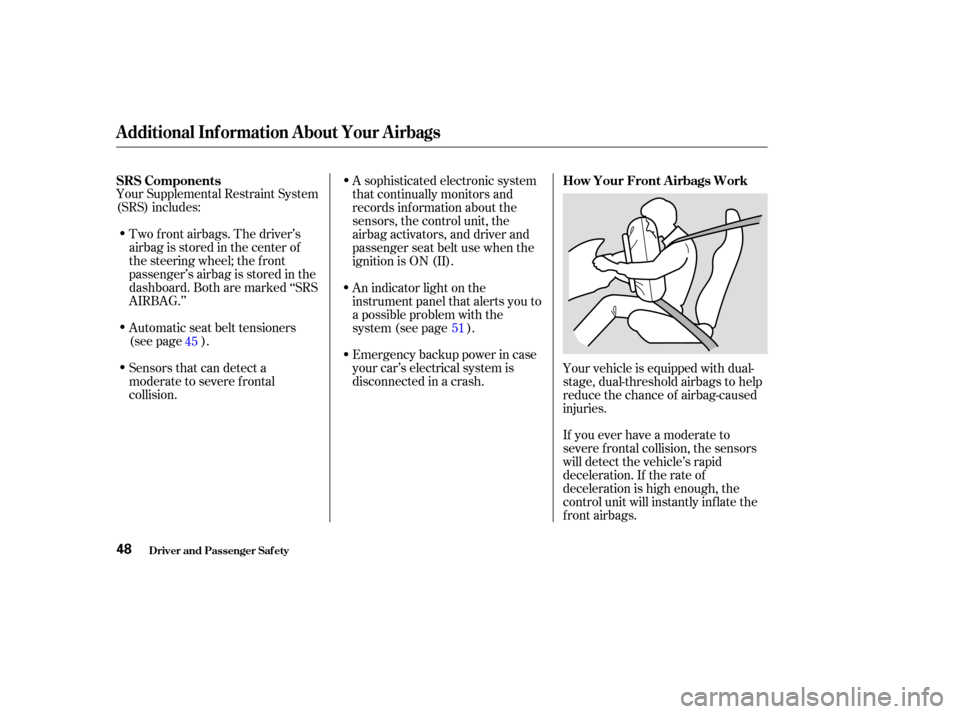
Your Supplemental Restraint System
(SRS) includes:Two f ront airbags. The driver’s
airbag is stored in the center of
the steering wheel; the f ront
passenger’sairbagisstoredinthe
dashboard. Both are marked ‘‘SRS
AIRBAG.’’ A sophisticated electronic system
that continually monitors and
records inf ormation about the
sensors, the control unit, the
airbag activators, and driver and
passenger seat belt use when the
ignition is ON (II).
Sensors that can detect a
moderate to severe frontal
collision. Automatic seat belt tensioners
(see page ). An indicator light on the
instrument panel that alerts you to
a possible problem with the
system (see page ).
Emergency backup power in case
your car’s electrical system is
disconnected in a crash.
If you ever have a moderate to
severe f rontal collision, the sensors
will detect the vehicle’s rapid
deceleration. If the rate of
deceleration is high enough, the
control unit will instantly inf late the
f ront airbags. Your vehicle is equipped with dual-
stage, dual-threshold airbags to help
reduce the chance of airbag-caused
injuries.
45
51
SRS Components
How Your Front A irbags Work
Additional Inf ormation About Your Airbags
Driver and Passenger Saf ety48
Page 60 of 320

This section gives inf ormation about
the controls and displays that
contribute to the daily operation of
your Acura. All the essential controls
are within easy reach............................
Control Locations .58
...............................
Indicator Lights .59
Maintenance Required ...................................
Indicator .64 .........
Security System Indicator . 65
.............................................
Gauges .66
...............................
Speedometer .66
.................................
Tachometer .66
.....................................
Odometer .66
...................................
Trip Meter .67
..................................
Fuel Gauge .67
...................
Temperature Gauge . 67
Controls Near the Steering .......................................
Wheel .68
...................................
Headlights .69
............
Daytime Running Lights . 69
....
Instrument Panel Brightness . 70
................................
Turn Signals .70
.....................
Windshield Wipers .71
..................
Windshield Washers . 72
Rear Window Wiper and .....................................
Washer .72
..........................
Hazard Warning .73
.............
Rear Window Def ogger . 73
......
Steering Wheel Adjustment . 74
...............................
Keys and Locks .75
..............................................
Keys .75
....................
Immobilizer System . 76
............................
Ignition Switch .77
..................................
Door Locks .79 .........
Power Door/Hatch Locks . 80
............................................
Hatch .80
...................
Remote Transmitter . 81
....................................
Glove Box .84
............................
Seat Adjustments .85
.............
Front Seat Adjustments . 85
Driver’s Seat Height ..............................
Adjustment .86
...........
Driver’s Lumbar Support . 86
........................
Rear Seat Access .86
...........................
Folding Rear Seat .87
....................................
Seat Heaters .88
...........................
Cargo Area Cover .89
..............................
Power Windows .90
.........................................
Moonroof .93
.............................................
Mirrors .94
....
Adjusting the Power Mirrors . 94
.................................
Parking Brake .95
..................................
Vanity Mirror .96
........................................
Coat Hook .96
.............................
Beverage Holder .97
...................
Console Compartment . 98
...............
Accessory Power Socket . 99
.................................
Interior Lights .99
Instruments and Controls
Inst rument s and Cont rols57
Page 71 of 320
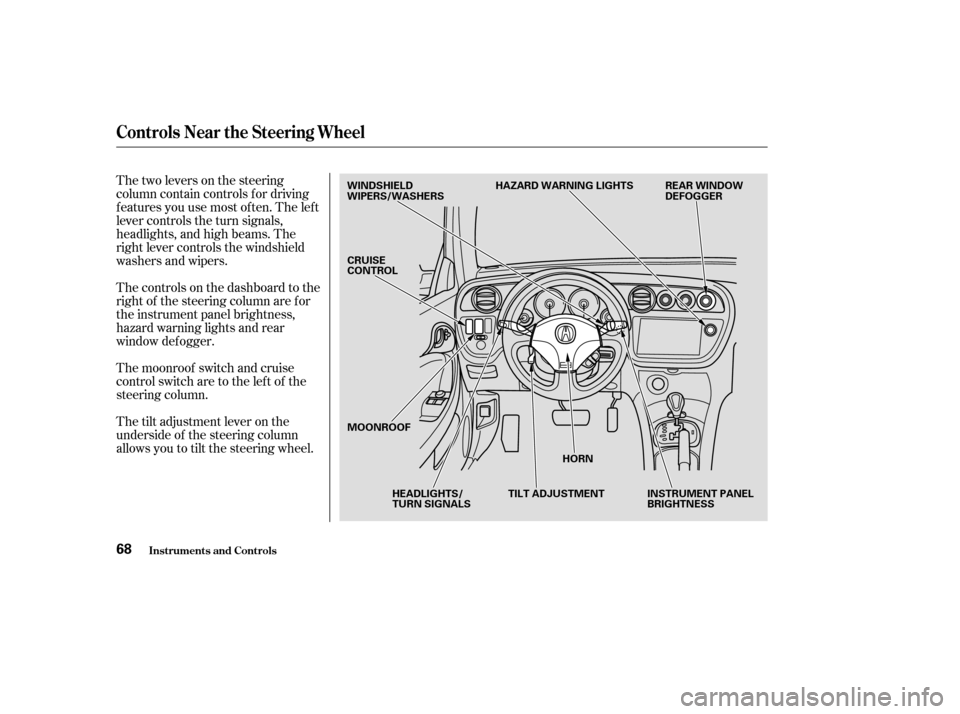
Thetwoleversonthesteering
column contain controls f or driving
f eatures you use most of ten. The lef t
lever controls the turn signals,
headlights, and high beams. The
right lever controls the windshield
washers and wipers.
The controls on the dashboard to the
right of the steering column are f or
the instrument panel brightness,
hazard warning lights and rear
window def ogger.
The moonroof switch and cruise
control switch are to the left of the
steering column.
The tilt adjustment lever on the
underside of the steering column
allows you to tilt the steering wheel.
Controls Near the Steering Wheel
Inst rument s and Cont rols68
WINDSHIELD
WIPERS/WASHERSHAZARD WARNING LIGHTS REAR WINDOW
DEFOGGER
INSTRUMENT PANEL
BRIGHTNESS
HORN
TILT ADJUSTMENT
HEADLIGHTS/
TURN SIGNALS
MOONROOF CRUISE
CONTROL
Page 72 of 320
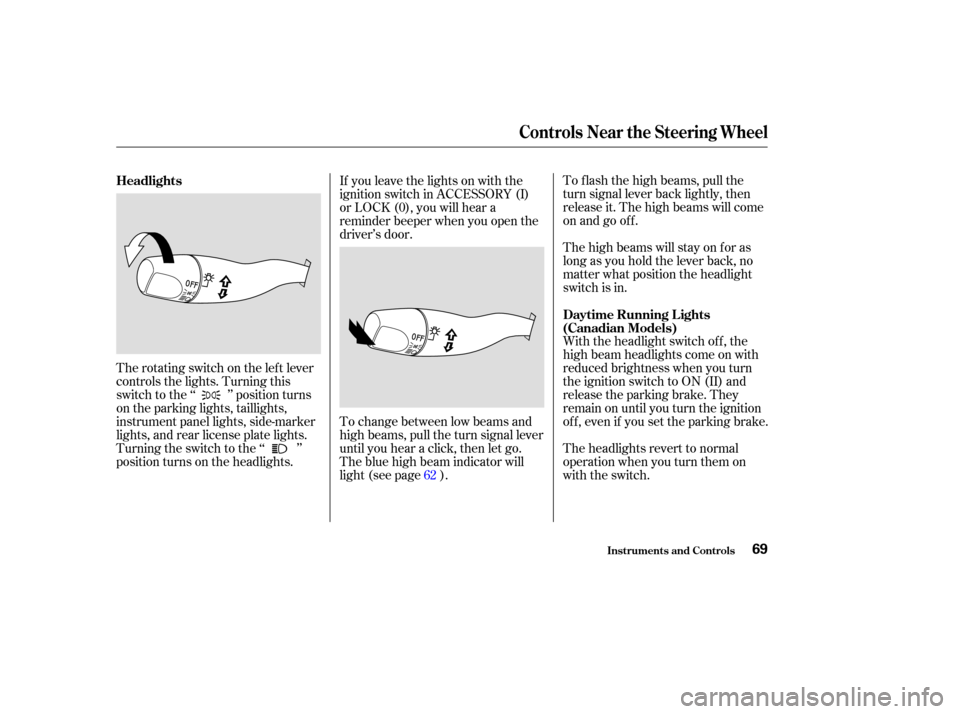
To f lash the high beams, pull the
turn signal lever back lightly, then
release it. The high beams will come
on and go of f .
The high beams will stay on f or as
long as you hold the lever back, no
matter what position the headlight
switch is in.
With the headlight switch off, the
high beam headlights come on with
reduced brightness when you turn
the ignition switch to ON (II) and
release the parking brake. They
remain on until you turn the ignition
of f , even if you set the parking brake.
To change between low beams and
high beams, pull the turn signal lever
until you hear a click, then let go.
The blue high beam indicator will
light (see page ). The headlights revert to normal
operation when you turn them on
with the switch.
The rotating switch on the lef t lever
controls the lights. Turning this
switch to the ‘‘ ’’ position turns
on the parking lights, taillights,
instrument panel lights, side-marker
lights, and rear license plate lights.
Turning the switch to the ‘‘ ’’
position turns on the headlights. If you leave the lights on with the
ignition switch in ACCESSORY (I)
or LOCK (0), you will hear a
reminder beeper when you open the
driver’s door.
62
Headlights
Daytime Running L ights
(Canadian Models)
Controls Near the Steering Wheel
Inst rument s and Cont rols69
Page 73 of 320

To signal a lane change, push lightly
on the turn signal lever in the proper
direction and hold it. The lever will
return to the center position as soon
as you release it.
Signal a turn or lane change with this
lever. Push down on the lever to
signal a lef t turn, and up to signal a
right turn. If you push it up or down
all the way, the turn signal continues
to blink even when you release the
lever. It shuts off automatically as
you complete the turn.
The knob on the instrument panel
controls the brightness of the instru-
ment panel lights. Turn the knob to
adjust the brightness.Inst rument Panel Bright nessTurn Signals
Controls Near the Steering Wheel
Inst rument s and Cont rols70
TURN SIGNAL LEVER
Page 74 of 320
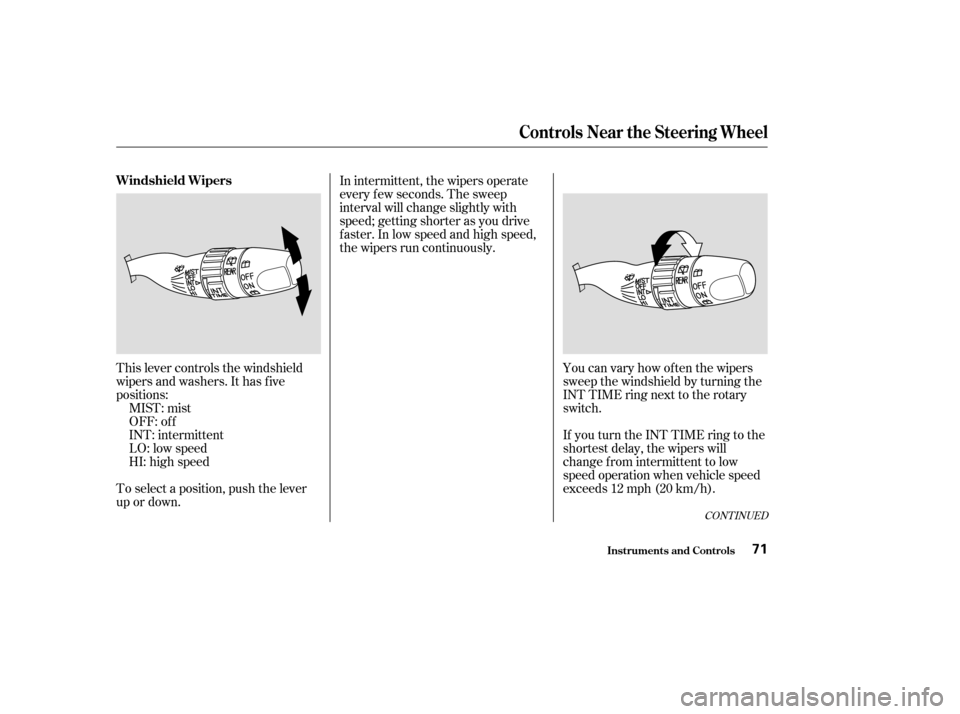
This lever controls the windshield
wipers and washers. It has five
positions:MIST: mist
OFF: off
INT: intermittent
LO: low speed
HI: high speed
To select a position, push the lever
up or down. In intermittent, the wipers operate
every f ew seconds. The sweep
interval will change slightly with
speed; getting shorter as you drive
f aster. In low speed and high speed,
the wipers run continuously.
You can vary how of ten the wipers
sweep the windshield by turning the
INT TIME ring next to the rotary
switch.
If you turn the INT TIME ring to the
shortest delay, the wipers will
change from intermittent to low
speed operation when vehicle speed
exceeds 12 mph (20 km/h).
CONT INUED
Windshield Wipers
Controls Near the Steering Wheel
Inst rument s and Cont rols71
Page 75 of 320
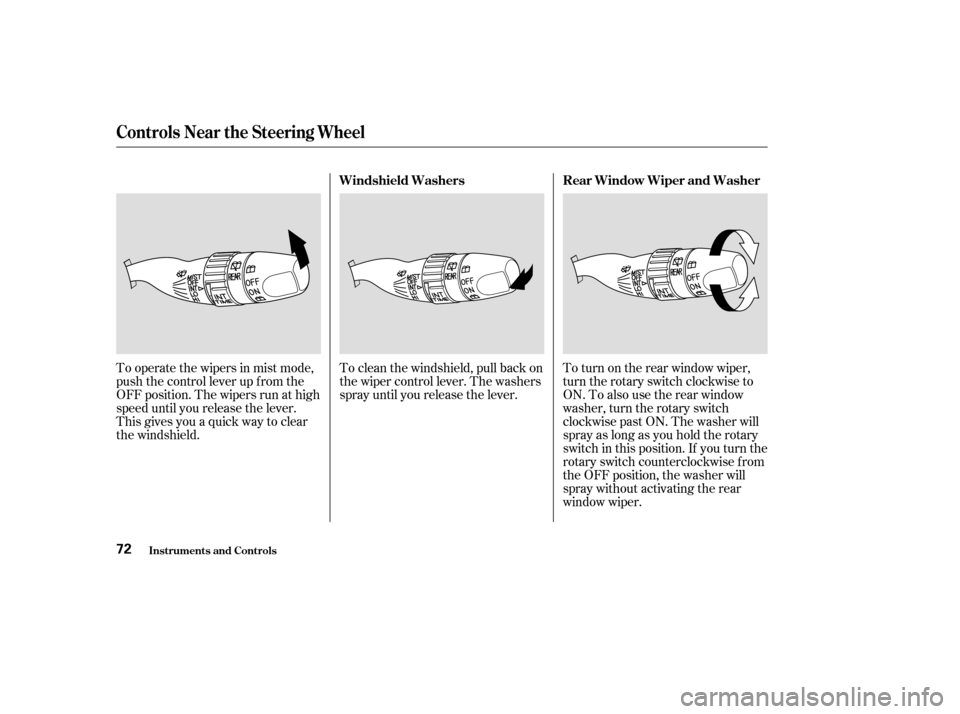
To operate the wipers in mist mode,
push the control lever up f rom the
OFF position. The wipers run at high
speed until you release the lever.
This gives you a quick way to clear
the windshield.To clean the windshield, pull back on
the wiper control lever. The washers
spray until you release the lever.
To turn on the rear window wiper,
turn the rotary switch clockwise to
ON. To also use the rear window
washer, turn the rotary switch
clockwise past ON. The washer will
spray as long as you hold the rotary
switch in this position. If you turn the
rotary switch counterclockwise f rom
the OFF position, the washer will
spray without activating the rear
window wiper.
Controls Near the Steering Wheel
Inst rument s and Cont rols
Windshield Washers
Rear Window Wiper and Washer
72
Page 76 of 320

The rear window def ogger will clear
fog, frost, and thin ice from the
window. Push the def ogger button to
turn it on and of f . The light in the
button lights to show the def ogger is
on. If you do not turn it of f , the
def ogger will shut itself of f af ter
about25minutes.Italsoshutsoff
when you turn of f the ignition. You
have to turn it on again when you
restart the car.
Pushtheredbuttontoturnonthe
hazard warning lights (f our-way
flashers). This causes all four
outside turn signals and both
indicators in the instrument panel to
f lash. Use the hazard warning lights
if you need to park in a dangerous
area near heavy traffic, or if your car
is disabled. Make sure the rear window is clear
and you have good visibility bef ore
starting to drive.
Thedefoggerwiresontheinsideof
the rear window can be accidentally
damaged. When cleaning the glass,
always wipe side to side.
Controls Near the Steering Wheel
Inst rument s and Cont rols
Hazard Warning
Rear Window Def ogger
73
Page 77 of 320
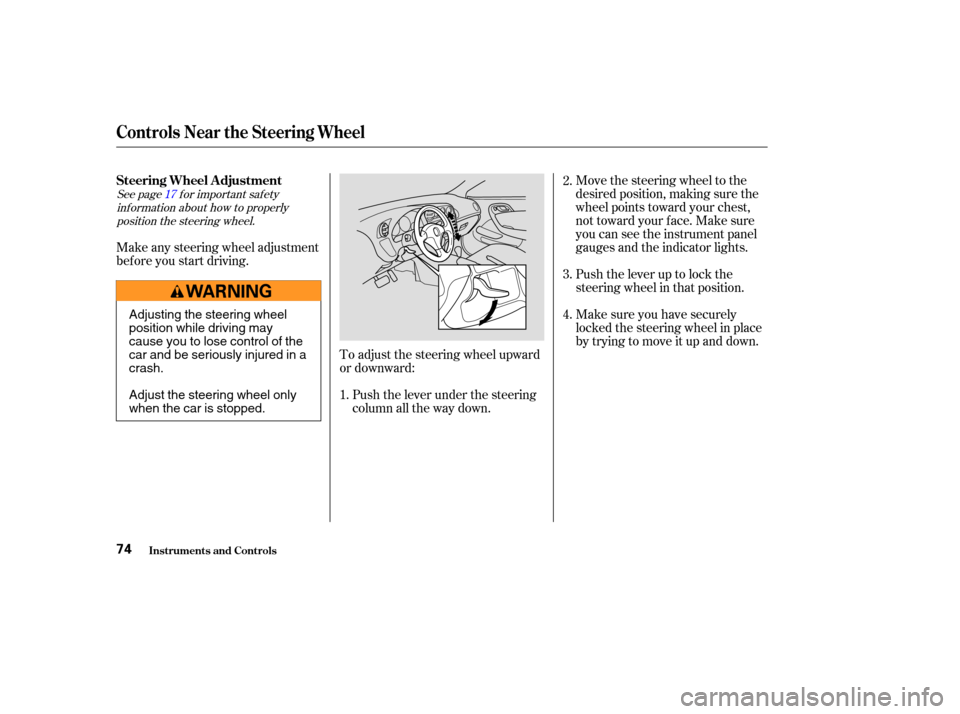
See page f or important saf etyinf ormation about how to properlyposition the steering wheel. 17
Make any steering wheel adjustment
bef ore you start driving.
To adjust the steering wheel upward
or downward:Push the lever under the steering
column all the way down. Move the steering wheel to the
desired position, making sure the
wheel points toward your chest,
not toward your f ace. Make sure
you can see the instrument panel
gauges and the indicator lights.
Push the lever up to lock the
steering wheel in that position.
Make sure you have securely
locked the steering wheel in place
by trying to move it up and down.
1. 3.
4. 2.
Controls Near the Steering Wheel
Inst rument s and Cont rols
Steering Wheel A djustment
74
Adjusting the steering wheel
position while driving may
cause you to lose control of the
car and be seriously injured in a
crash.
Adjust the steering wheel only
when the car is stopped.